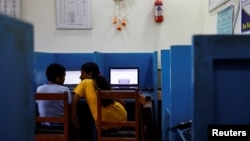With 90% of the population online, misinformation can spread fast in Nepal. But efforts by the government to regulate the digital sphere are raising flags with media and legal analysts.
Earlier this year, Nepal’s government passed amendments to the National Broadcasting Regulation to regulate online videos. The change means that any medium or person wanting to post a video online must first purchase a license for 500,000 rupees ($3,900).
The push for change came after a rise in complaints filed over sensationalist YouTube videos deemed to be tarnishing the image of public figures and officials.
The new ruling will make communicating online — both for journalists and online users — prohibitively expensive, says media watchdog Reporters Without Borders. The minimum monthly wage for a journalist in Nepal, which has set limits for professions, is 25,000 rupees ($313).
Nepal’s media community has also questioned why the National Broadcasting Act, which handles frequencies, is being used to regulate online content.
The Federation of Nepali Journalists, which opposed to the amendment, says it also goes against rights guaranteed by the 2015 constitution, including “complete press freedom.”
The government is trying to control the media through regulations, which have been condemned by journalists in Nepal, Roshan Puri, general secretary of the federation, told VOA.
“Due to the protest and subsequent discussion with the government, the bill has been withheld and has not been implemented,” he said.
Binod Dhungel, an independent journalist and correspondent for RSF in Nepal, says if the plan is implemented it could carry serious implications for news organizations.
“If implemented strictly, it will have a severe impact on freedom of expression, freelancers and [the] public,” Dhungel told VOA.
The journalist said several cases of sensational content posted online, particularly on YouTube, led to the change.
The posts did not originate with the media, but Dhungel believes the videos “pushed the government to make amendments in the existing law.”
Sometimes, in the name of managing “sensational content,” authorities infringe on fundamental rights, which is not acceptable, he said.
Tanka Dhakal, a journalist for the Kathmandu-based digital outlet DeshSanchar, told VOA that fees for the simple act of starting an internet video channel amount to a covert kind of censorship that will affect Nepal’s media, independent journalists and the public.
“For me, this new decree (regulation) is a weapon to silence the independent voice. It will ban independent journalists and creators from forming their views for a larger audience. If I want to start something new and fresh, that is not possible for me under the new law,” Dhakal said.
The Ministry of Communication and Information Technology in Nepal did not respond to VOA's request for comment.
Nepal is in a relatively new era of democracy after the end of a 240-year-old monarchy in 2008. Residents of the Himalayan nation have access to a range of media outlets. RSF research cites 4,800 periodicals, 880 radio stations, 160 TV networks, and over 3,100 websites.
The media watchdog also noted that the government owns a large stake in the media environment although “its dominance is challenged by innovative news sites.”
The landlocked country, with a population of 29 million, is very active online.
As of January 2022, the country had more than 27.7 million broadband internet users — more than 90 percent of the total population — data from the Nepal Telecommunications Authority shows. When it comes to social media, 13.7 million people actively use the platforms, according to the internet statistics company DataReportal.
In a country actively accessing news and information online, the government should consider other options, journalists say.
“Rather than charging the fees, there are other means to regulate sensational videos by identifying the miscreants and taking legal action against (them) if found guilty,” said Dhungel.
Tanka Aryal, an attorney and founder of the nonprofit Digital Rights Nepal, noted that the proposed amendments fall under the National Broadcasting Regulation but, he said, posting video on social media doesn’t come under the purview of broadcasting as it doesn’t use the public frequency or fulfill the requirement of public broadcasting.
The amendment is vague in terms of terminology and scope, Aryal told VOA.
Aryal, whose nonprofit promotes the protection of rights on and offline, warned of a spillover effect if the law is implemented. Many freelancers and individuals could see limits on freedom of expression if they cannot comply with the regulations, he said.
With the risk of mis and dis-information ahead of elections scheduled for November, the government has considered a number of laws that Digital Rights Nepal says could also limit rights.
Aryal cited other proposed bills including those focused on public service broadcasting, information technology, and the Media Council— that he says have provisions that could affect or be used to control media or freedom of expression.




